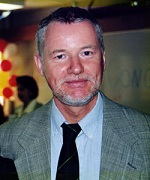

David A. Mathers
Associate Professor Emeritus
Associate Professor: Cellular & Physiological Sciences, UBC
National Institutes of Health, USA, 1979-80
Munich Technical University, 1978-79
Postdoctoral Fellow: Lund University, Sweden, 1977-78
PhD Zoology: Nottingham, 1976
Associate Member: Anesthesiology, Pharmacology & Therapeutics, UBCBSc (Hon) Zoology: Edinburgh, 1973
Email: david.mathers@ubc.ca
Office: 604-822-5684
Research Interests
Glycinergic and GABAergic Neurotransmission, Anesthetic and Analgesic Drug Actions, Patch Clamp ElectrophysiologyThe thalamus plays a key role in maintaining consciousness and in perception of sensory inputs, including pain. Traditionally, the major inhibitory neurotransmitter in thalamic nuclei was thought to be γ-aminobutyric acid (GABA). Our recent studies show that thalamic inhibition is much more heterogeneous than hitherto imagined. Electrical stimulation of sensory pathways evokes inhibitory synaptic responses mediated by the neurotransmitter glycine in many dorsal thalamic neurons. These glycinergic currents are themselves heterogeneous, decaying with rapid or slow time courses.
The thalamus is an important site of action for anesthetic drugs, long believed to act mainly by potentiating synaptic currents mediated by GABA. However, we have shown that the anesthetic barbiturate pentobarbital has multiple, additional actions that also inhibit cell firing, including activation of leak conductance and inhibition of inward rectifiers. Amobarbital, a chemical isomer of pentobarbital, affects only GABA responses. The anticonvulsant barbiturate phenobarbital has little effect in thalamus, but potentiates GABA currents in neocortical neurons. These results show that anesthetic action is highly structure- and brain region-dependent and that anesthesia likely involves drug actions at many membrane receptors and ion channels in the thalamus.
Mathers DA, Wan X, Puil E.
Barbiturate activation and modulation of GABA(A) receptors in neocortex.
Neuropharmacology. 2007 52:1160-8.
Ghavanini AA, Isbasescu IM, Mathers DA, Puil E.
Optimizing fluctuation analysis of GABAAergic IPSCs for accurate unitary currents.
J Neurosci Methods. 2006, 158:150-6.
Ghavanini AA, Mathers DA, Kim HS, Puil E.
Distinctive glycinergic currents with fast and slow kinetics in thalamus.
J Neurophysiol. 2006, 95:3438-48.
Ghavanini AA, Mathers DA, Puil E.
Glycinergic inhibition in thalamus revealed by synaptic receptor blockade.
Neuropharmacology. 2005, 49:338-49.
Ran I, Mathers DA, Puil E.
Pentobarbital induces thalamic oscillations in brain slices, modulated by GABA and glycine receptors.
Neuropharmacology. 2004 Dec;47(7):985-93.
Kim HS, Wan X, Mathers DA, Puil E.
Selective GABA-receptor actions of amobarbital on thalamic neurons.
Br J Pharmacol. 2004, 143:485-94.
Wan X, Mathers DA, Puil E.
Pentobarbital modulates intrinsic and GABA-receptor conductances in thalamocortical inhibition.
Neuroscience. 2003,121:947-58.
Yakubovich N, Eldstrom JR, Mathers DA.
Lipopolysaccharide can activate BK channels of arterial smooth muscle in the absence of iNOS expression.
Biochim Biophys Acta. 2001,1514:239-52.